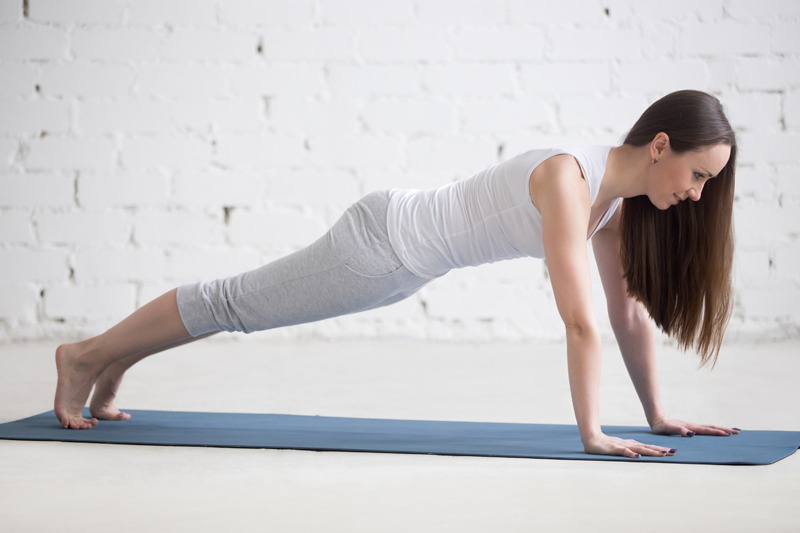
Yoga Poses for Radiant Skin
November 22, 2018
How to Practice Yoga in Group
November 29, 2018Yoga Poses for IBS Symptom Relief

If you’re one of the many people who suffer from irritable bowel syndrome, you’ll understand the discomfort associated with the disorder. Often referred to as IBS, irritable bowel syndrome is a common disorder that affects the large intestine. Signs and symptoms include abdominal pain, cramping, bloating, gas, and diarrhea or constipation. Although some people suffer from both diarrhea and constipation, most people experience one or the other. There is no known cure for the disorder, but most people can manage their symptoms with medication, natural remedies, and lifestyle changes. According to recent studies, regular yoga practice can reduce the symptoms of IBS. To reduce pressure on the abdomen, pick up some yoga pants with a flexible waistband before beginning. In this article, we explore some of the best yoga poses for IBS symptom relief.
Gate Pose
One of the best poses to soothe IBS symptoms is Gate Pose. To practice the asana, start by kneeling on your mat. Next, stretch your right leg out to the side, keeping the sole of your foot on the floor. Take a deep breath in and lift your left arm up; as you exhale, lean your body over your right leg. Rest your yoga block on the floor or your right shin and place your right hand on top. Reach your left arm to the side, noticing how the movement increases the stretch. Choose a position to rest your head and neck, ensuring that you’re not straining the muscles. Relax your face by softening your forehead, mouth, and jaw. You are in Gate Pose. Hold the asana for around 30 seconds before repeating on the other side. After completing the pose on both sides, return to a kneeling position and breathe patiently and fully.
Half Seated Spinal Twist
To practice Half Seated Spinal Twist, begin in a seated position. Stretch out your left leg and cross your right leg on top. Place the bottom of your right foot flat on the mat next to your left knee. Next, bend your left knee and move your left foot to the outside of your right hip. Spread your weight evenly and lengthen your spine. Gently turn your torso towards your right leg and hug your right knee with your left arm. Alternatively, you can bring your left elbow across your right leg and press your outer thigh into your upper arm. On your next exhale, draw your belly button towards your spine and twist your body a little further. You are in Half Seated Spinal Twist. Hold the asana for 30 seconds before repeating on the other side. If the twist feels too uncomfortable, try twisting in the opposite direction instead. This adaption gives the abdomen more space to relax and breathe.
Reclining Abdominal Twist
To practice Reclining Abdominal twist, begin lying on your back with your legs straight. As you breathe out, hug your right leg and draw it into your stomach. Remain in this position for a couple of breaths. Next, bring your right leg across your body and roll onto your left side. Keeping your right arm straight, reach it back with your palm facing up. Allow your shoulder blade to come off the mat so that the spiral of the asana moves from your legs through your spine, pelvis, ribs, and chest. You are in Reclining Abdominal Twist. Hold the asana for around 30 seconds before repeating on the opposite side. If the stretch feels too uncomfortable, try placing a support underneath your right knee.

Supported Bridge Pose
To practice Supported Bridge Pose, start by placing a blanket, bolster or block underneath your hips. When this is in place, lie back on your mat. It’s important to keep the support under your pelvis, not your ribs or lower back. Next, extend your legs and rest your arms palm-up on the mat. If you’re using a strap, place it around your thighs to keep your legs in place. Tighten the strap enough for you to completely relax your legs, but not so much that your legs are being squeezed together. If you don’t have a strap to hand, don’t worry; instead, you can rest the soles of your feet against a wall for support. You are in Supported Bridge Pose. Hold the asana for 1 minute or as long as it feels comfortable. Whilst you hold it, notice how your breath moves through the body and feel the tension dissolve.
Happy Baby Pose
To practice Happy Baby Pose, start by lying on your back. As you inhale, hug your knees into your chest and relax your back into the mat. As you exhale, spread your knees apart and reach the bottoms of your feet toward the ceiling. At this stage, keep your legs bent and your feet directly above your knees. To hold your legs in place, hold on to your big toes or the sides of your feet. Allow your body to relax into the pose, without pulling yourself deeper into it. Straighten your arms and rest them by your sides. As you take the weight off your hips, ribs, and lower back, you should feel a deep stretch in your groin and hips. You are in Happy Baby Pose. Hold the posture for 1 minute whilst focusing on your breathing.
In Summary
In the US, over 45 million people suffer from IBS. Although medication can relieve symptoms, some people prefer to use natural pain relief. When used regularly, yoga can soothe the symptoms of IBS and even prevent them from reoccurring. If you’re new to yoga, start by using the above yoga poses for IBS symptom relief. If you’re practicing independently, make sure to pick up the right equipment before getting started. To minimize pressure on the stomach, it’s best to wear a lightweight yoga vest and sweatpants with a flexible waistband.

